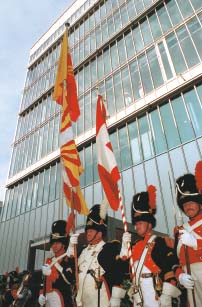
(UIT 990087)

(UIT 990087)
On 9 October 1999 Ruth Dreifuss, President of the Swiss Confederation and Martine Brunschwig Graf, President of the State Council of the Republic and Canton of Geneva, inaugurated ITU's new "Montbrillant building" in the presence of two hundred invited guests from the diplomatic community and from the city, cantonal and confederation administrations. Completion of this new building, which complements the Union's existing Tower and Varembé buildings, reflects the expanding role of the ITU in the world of telecommunications.
The Montbrillant building offers delegates to ITU's many conferences and meetings exceptionally modern facilities with advanced communication technology. It features networking solutions wired into the building, allowing remote simultaneous-interpretation services and Web broadcasting, which enables virtual participation in Geneva-based meetings from remote locations anywhere in the world. Delegates can sit at desks featuring power and communication ports for their laptop computers, and documents can be sent directly to their laptop screens during meetings, as well as being projected on large screens. In the library on the top floor, they can consult a wealth of online and stored electronic information via multimedia workstations. The building also includes a computer and telephone switching centre, as well as office space for nearly 100 staff.
The building also employs high technology. Its glass filters some of the sun's infrared rays, and on warmer days semi-transparent shutters descend automatically as an additional heat-protection veil. The curved glass roof, assembled from prefabricated sections which significantly reduced construction time, allows light to pour into the building's atrium. Light is an integral part of the building's design, creating an atmosphere that facilitates open communication.
Designed by Jean-Jacques Oberson, architect of Hewlett-Packard's headquarters and the Firmenich building in Geneva, the Montbrillant building combines high technology from the construction field with a simple form to mark the transition of Geneva, at the Place des Nations, from urban centre to parks and wooded areas. The inauguration ceremony was conducted by Mohamed Harbi, Head of Strategic Planning, External Affairs and Corporate Communication Units.

Our presence for the inauguration of this building serves to connect the end points in the history of the international organizations: here we have the newest of buildings for the most senior of those organizations. Proof, if it were needed, that the international organizations, however old they may be, are in the midst of a boom and fulfil an indispensable role in their respective sectors.
The International Telecommunication Union is certainly doing so. It has the essential task of managing all the most basic aspects of the information society. As a platform for the development of global strategies, it enables the benefits generated by the development of new technologies to be enjoyed by the maximum number of countries and individuals. It is easy to understand why the need for such an organization has been affirmed throughout its years of existence: telecommunications, being quintessentially concerned with overcoming distance and crossing borders, require international management.
I am pleased that ITU has its headquarters in Geneva. It blends perfectly with the spirit of this city, where the commitment to dialogue and exchange prevails. The Federal Council is, of course, fully aware of the importance of the international organizations to Geneva and to Switzerland. Thanks to them, Geneva is today one of the centres for multilateral meetings in the economic, social and humanitarian fields. For that reason, the Confederation has always been committed to improving the working conditions of the Geneva-based organizations. It was therefore only natural that the Federal Council and the parliament should finance the construction of this building.
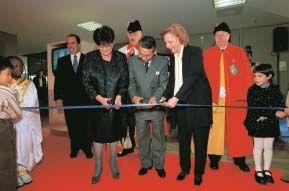
Ribbon-cutting ceremony (ITU 990088)
Today, some eight hundred people work at ITU. With this new building, they will enjoy the benefit of a working environment adapted to the requirements of their tasks, which have grown unceasingly in recent years. As you know, the decade that is now coming to a close has seen unprecedented developments in the field of telecommunications. Mobile telephony and the Internet have radically transformed our everyday lives. This revolution in communication technologies is far from having run its course, which means that ITU will be at the centre of events in the coming century.
Telecommunications have become the very symbol of our modernity. While we readily talk about the virtual world in this connection, the challenges associated with it are very real. Information, education, trade, improving human welfare, the list goes on and on: today, practically all human activity is dependent on global telecommunication networks. In this multifaceted context, ITU fits quite naturally into the activities of international Geneva, whether they relate to the economy, development or humanitarian issues. As a necessary stage in every form of exchange, telecommunications should serve to link up all these activities, reminding us that progress — if it is to deserve that name — must be shared by the greatest number.
Ruth Dreifuss

The inauguration of anew building, when it concerns an international organization as important as ITU, is a notable occasion for the Geneva authorities, enabling us as it does to appreciate fully the considerable scope and importance of this organization's activities at the service of people everywhere.
As builders and architects know full well, human activities are central to the concerns of those who design and build. An architectural and technical work does not have to please the eye; rather, its true value lies in the manner in which it facilitates the lives and interactions of all those who, in this case, will henceforth be working here in the service of the International Telecommunication Union.
Mr Secretary-General, today [9 October 1999] you officially receive the keys to ITU's new building. We see in this the symbol of your determination, together with the organization you direct, to serve the international community even more energetically.
Since 1948, ITU has played a key role in Geneva, forging invaluable links in the technical, economic, social and political spheres. Your organization keeps pace with technological advances, anticipating them, supporting them and laying down the standards which enable progress to extend to all the continents.
On behalf of the Geneva authorities, I can only express the wish that you, Mr Secretary-General, and all your fellow workers, find here the best possible conditions for the further intensification of ITU's increasingly indispensable activities. You have placed your confidence in us by selecting Geneva for the 2003 Telecom exhibition. That is a further way of showing our Republic and Canton that together we have links to forge, projects to develop and activities to implement.
Given its firm commitment to cutting-edge technologies thanks to the many and varied enterprises established here, and anxious to establish adequate research facilities, Geneva is delighted to see you setting down even deeper roots in a city that is already your home.
Martine Brunschwig Graf
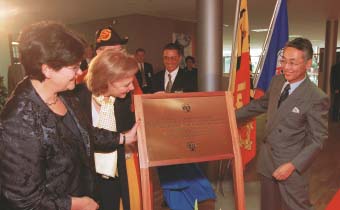
Ruth Dreifuss, Martine Brunschwig Graf and Yoshio Utsumi unveil the commemorative plate (ITU 990089)

Whilst the Tower building will remain the main building of the ITU, the completion of this third building is timely for the operational needs of the Union on the eve of the new millennium. I think the features of the building that our delegates will appreciate most will be its extensive use of modern technology to facilitate communication and information management, both vital ingredients in the mandate and work of ITU. As for me personally, I particularly like the building's delightful use of light and the energy-conservation concept in the design.
It was the long-term loan extended by the Swiss authorities that rendered feasible the funding by the ITU Members of the construction of the "Montbrillant building". As Secretary-General of the ITU, I sincerely thank the Swiss authorities for this generous loan, as well as for the additional loan they have recently granted to the ITU to build a new cafeteria overlooking the ITU park next to the Montbrillant building.
I would also like to take this opportunity to express some additional special thanks to the architect, the consulting engineers and the general contractor Construction Karl Steiner SA whose efforts and teamwork turned plans into efficient reality, to the Fondation des immeubles pour les organisations internationales (FIPOI) for their continuous advice and support; and to the staff of the ITU Secretariat who planned, coordinated and supervised the project.
It gives me great pleasure to be associated with the completion of the Montbrillant building.
Yoshio Utsumi
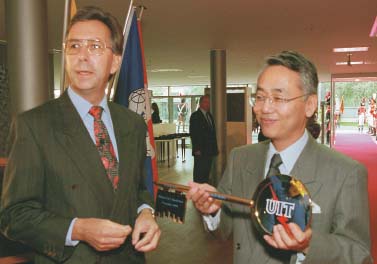
Hand over of the symbolic key to the Secretary-General by Karl Steiner, Chairman of Construction Karl Steiner SA
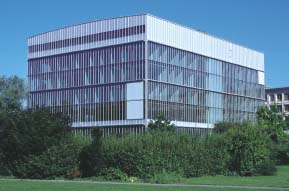
It could be argued that the building is somewhat avant-garde in its use of technology in telecommunications (UIT 990091)
In 1992, ITU launched an architectural competition for the design of what is now known as the "Montbrillant building".
A jury was formed, comprising a number of well-known Swiss architects, representatives of the Canton of Geneva involved in town planning and building projects, and one ITU staff member.
The architectural competition presented two interesting challenges.
The first was that the external shape of the building needed to be in harmony with the surrounding buildings, since it was recognized that a building of unsuitable form could clash, in particular, with the elegant shape of the World Intellectual Property Organization (WIPO) building; and it also needed to fit in with the then-envisaged development of the area around the Place des Nations. The master plan for the development of the area has since been postponed, and a new and very modest master plan is due to be unveiled early in 2000.The second design challenge was to satisfy ITU's complex functional specifications on a relatively small plot of land and within the height limitations imposed by the authorities of the Canton of Geneva. Following a unanimous jury decision, the architectural design of the Montbrillant building was awarded to Jean-Jacques Oberson.
The construction contract was awarded to Construction Karl Steiner SA in May 1997. Construction work began in June of the same year.
The simple form of the building, as a transparent cube with a slightly curved roof, is abstract in concept with hints of the role of technology in the future, echoing ITU's technical mandate. As the building neared completion, its external form became an interesting topic of conversation amongst both laymen and specialists. Some found its shape too austere, some said it was too large and hid the beautiful view of the WIPO building they enjoyed before, and some admired its abstract statement. Few, if any, have stayed indifferent.
Those who have been inside the building find the architect's use of light delightful and ingenious. Light was a central theme in the architect's design to facilitate communication and interaction among the users of the building, and particularly among the delegates from industry and government who come together there to address global telecommunication issues.
The transparency of light hides the extensive use of technology in the building. In fact, it could be argued that the building is somewhat avant-garde in its use of technology.
Documents under discussion can be provided electronically and projected on screen to facilitate multilateral negotiations. Advanced networking also provides for remote interpretation services, and Web broadcasting will enable virtual participation in Geneva-based forums from the four corners of the world. If the day comes when paperless meetings become the norm, the Montbrillant building will be ready for it and will enable Geneva to play the leading role in this new future. The small library located on the top floor is another indication that ITU has built the Montbrillant building for the future. It has a small collection of paper books and journals, but its multimedia workstations are the visible artefacts of the underlying concept of a virtual library centered on the convergence of telecommunication and information technologies.
The special glass used on the facade cuts some of the infrared rays — but not enough for the architect's energy-conservation design. During warm summer days therefore, as the sun rises, the building facade will automatically cover itself with a veil of semi-transparent shutters against the heating effect of the sun. Inside, the ventilation system brings in fresh air, cooled or heated as necessary for maximum professional comfort.
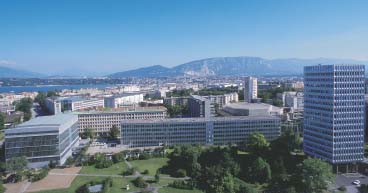
View of the three ITU buildings: in the centre, the Varembé building, inaugurated in 1962;to the right, the Tower building, inaugurated in 1973; to the left, the new Montbrillant building (ITU 990092)
The Kyoto Plenipotentiary Conference (1994), gave the final go ahead for the construction of the Montbrillant building based on Mr Oberson's preliminary design, with the Member States of ITU authorizing a budget envelope of CHF 55 million. The Swiss authorities in 1996 granted a loan of 49 million for the construction of the project, inclusive of all costs and possible modifications to the detailed design. The loan is generously interest-free, repayable over fifty years.
An independent survey by the Office of Federal Construction concluded that the Montbrillant building was the second most cost-effective building among all administrative buildings in Switzerland in recent years, as measured by "francs per square metre". The final cost of the building will not exceed CHF 47 million, inclusive of the modifications to the adjoining Varembé building resulting from the connecting skywalk.
How was this achieved for such a modern, complex building? There were a number of key factors that contributed to this success.
ITU's competitive bidding procedure maximized the benefits of favourable economic conditions prevalent at the time in the construction industry.
Another factor was the choice of a competent general contractor who planned for fast construction, which took two years and three months from contract signature to final delivery.
The contract model, innovative particularly for Switzerland, also played a key role in keeping expenditures down. In a framework of clear responsibilities for each party, the contract attempted to minimize risks for both parties. For example, instead of separate insurance covers for the owner and the general contractor, the contract stipulated a single "umbrella" insurance to minimize litigation risks.
The Government of the Republic of Seychelles has acceded to the above-mentioned Constitution and Convention as well as the amended Instruments.
General Dynamics Information Systems, Inc. (Bloomington, MN) and Optaphone Systems, Inc. (Rohnert Park, CA) have been admitted to take part in the work of this Sector.
NetRidium Communications, Inc. (Tustin, CA) has been admitted to take part in the work of this Sector.
International Council of Scientific Unions (ICSU), which participates in the work of the Radiocommunication Sector has changed its name. The new denomination is: International Council for Science (ICSU).
International Digital Communications Inc., which participates in the work of the Standardization Sector has changed its name. The new denomination is: Cable & Wireless IDC Inc.
North American National Broadcasters Association (NANBA) which participates in the work of the Radiocommunication Sector has changed its name. The new denomination is: North American Broadcasters Association (NABA).
Pirelli Cavi e Sistemi S.p.A. (Milan, Italy), which participates in the work of the Standardization Sector has not changed its name (see ITU News, No. 6/99, page 9).
A circular letter which has been sent to all Member States and Sector Members of the Union announces the following vacancy:
Detailed applications with ITU personal history form should be submitted to the General Secretariat of the ITU, Place des Nations, CH–1211 Geneva 20 (Switzerland), no later than the final dates mentioned above.
Vacancy notices and personal history forms are available on the ITU Web site, under the "ITU General Secretariat" section: http://www.itu.int/.